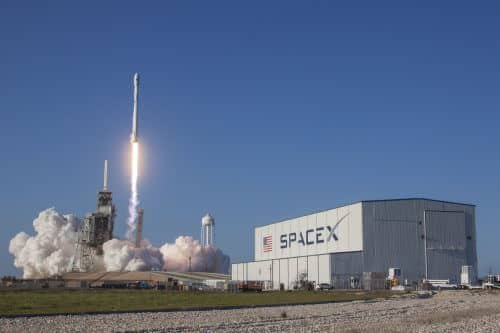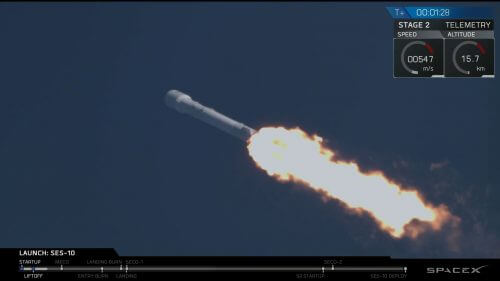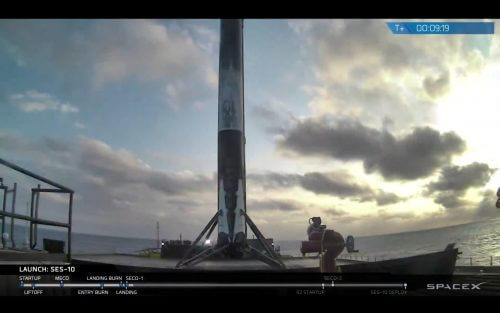SpaceX launched early this morning (Israel time), for the first time in the company's history, a Falcon 9 launcher with a used first rocket stage, which was launched a year ago and returned by landing on a marine rig. In doing so, the company achieved its goal of creating a partially multi-purpose launch system (the upper rocket stage of the launcher is not returned to Earth), which will help reduce the costs of launching into space. After the successful launch, the used first stage managed to land, once again, on an offshore rig in the middle of the sea. Elon Musk was excited and said: "We proved that it is possible to do something that many people said was impossible."

SpaceX launched today at 01:27 (Israel time) the communication satellite SES-10, and for the first time - the launch was carried out using a Falcon 9 launcher with a used first rocket stage. During today's launch, the rocket stage operated without any malfunctions and even managed to land back, for its second time, on a marine rig in the middle of the sea. The used first stage, numbered 1021, was last used on April 8, 2016, during the launch of the CRS-8 mission, an unmanned Dragon spacecraft delivering supplies to the International Space Station.
Since the historic success of SpaceX in December 2015, in which she succeeded land for the first time The first rocket stage of the Falcon 9, SpaceX was able to repeat the success again and again. The company has returned 8 first stages up to today's launch, 5 landing on a marine rig, and 3 landing on a ground pad.
But only now has SpaceX been able to truly fulfill the goal set by company founder Elon Musk - to develop a multipurpose launcher that will help reduce the costs of launching into space. For the sake of accuracy, it is worth noting that Falcon 9 is not completely multi-purpose - only its first rocket stage, the main part of the launcher, returns to Earth, while the upper rocket stage, which puts the payload into orbit around the Earth, burns up in the atmosphere.

Elon Musk said after the success of the renewed launch: "This is an amazing day for space, and for the space industry as a whole. This means that it is possible to fly and re-fly an orbital booster [orbital booster - he probably means the first rocket stage - AK], which is the most expensive part of the rocket. It will ultimately be a huge revolution in spaceflight."
Musk seemed a little moved, and later he said: “It took us 15 years to get to this point. It took us a long time. There were many difficult steps along the way, but I am very proud of the SpaceX team that managed to achieve an amazing milestone in the history of space, and I am a little speechless, but this is an amazing day not only for SpaceX but for the entire space industry. We proved that something that many people said was impossible could be done."
Watch Elon Musk speak after today's historic success:
This is not the first time that the used first stage that was successfully launched and landed today makes history. In his first mission, last year, he became the first that SpaceX managed to land on a mobile rig in the middle of the sea. Landing in the middle of the sea allows SpaceX to launch satellites into a higher orbit around the Earth, by using more fuel in the launch itself, which would normally be reserved for rocket combustion that is responsible for returning the rocket stage to the ground landing pad on land.
After landing on the Mobile Offshore Rig last year, the rocket stage underwent several tests and combustion experiments that showed it was capable of another space launch. First Spice X She planned to turn it into a test rocket that will undergo additional combustion tests and will not be launched into space again, but in the end another first stage that was launched under more extreme conditions will be designated for this.
Today's successful launch, which was carried out from the Kennedy Spaceport in Florida, was also the first in which SpaceX attempted, and succeeded, in retrieving both parts of the payload fairing (Payload fairing) in the nose of the missile. The envelope protects the payload during launch, and the two parts that make it up break apart and fall when the atmosphere becomes thin enough. In a telephone press conference, Musk said that the two parts of the shell made a soft landing on the waters of the Atlantic Ocean, using rocket boosters installed in them and parachutes that could be steered, so Report on space.com. According to Musk, reusing the payload fairing will also significantly help reduce launch costs. According to him, their development cost per launch is approximately $6 million, out of approximately $62 million per launch today. "This is the icing on the cake," Musk told reporters.

The Falcon 9 launcher, like most space launchers, is multi-stage. It consists of two rocket stages - the first stage has 9 engines Merlin 1D that SpaceX produces, and it puts the upper stage and the payload into a ballistic trajectory, and then detaches from them and returns to Earth using aerodynamic fins and rocket burns, in which it uses the remaining fuel in its tanks to land on a land or sea lander. The upper rocket stage goes into action after disengagement, and using a single Merlin 1D engine puts the payload into the desired orbit - but the upper stage itself is unable to return to Earth and burns up in the atmosphere.
A reusable launcher, even a partial one, could completely change the face of the expensive space launch industry. Today, all orbital space launchers, except for SpaceX, are disposable - after launch they fall and burn up in the atmosphere, with no attempt to recover and reuse them. The only other launch system that was also partially multi-purpose was the space shuttle - in which the shuttles themselves were reused and the lateral acceleration rockets (who landed using parachutes), but not bThe external fuel tank, which burned up in the atmosphere. The space shuttles, it's worth noting, have proven extremely expensive despite their reusability, and they haven't been able to reduce launch costs as much as SpaceX hopes to do.
Incredibly of the SpaceX team for achieving this proud milestone in space! Next goal is reflight within 24 hours.
- Elon Musk (@elonmusk) March 30, 2017
To make the vision of multi-use a routine reality, SpaceX must greatly shorten the amount of time it takes to prepare the returned first stages for another launch. According to Gwen Shotwell, SpaceX's chief operating officer, the process of preparing the current first stage for a relaunch took four months. In the future, according to Shotwell, the company wants to make the first stage "like an airplane", and reuse it the same day it lands.
Last year Elon Musk revealed his long-term vision for SpaceX - Establish a manned colony on Mars. To accomplish this, the company intends to develop a huge manned spacecraft, which will be launched by a super launcher, the likes of which has never been seen before. SpaceX hopes that the launcher will be able to re-land already at the launch pad and thus be ready very quickly for its next launch. Let's hope that today's historic success will help realize this ambitious vision.
Watch the successful launch of the Falcon 9 launcher with a used first stage:

4 תגובות
Long live a stranger
"Take off and land at any airport" of course not - and spaceships will not take off and land in special fields anytime soon either.
The reason is simple: initial weight (including fuel rocket engine + oxidizer and life support system) and required performance (orbital speed) do not fit into a plane that can take off from 2.5 km. Keep in mind that such an aircraft needs wings with a relatively low lift (because of the speed) and thermal insulation consisting of porcelain bricks (that is, added weight and aerodynamic cross-section) and all this living beauty stands on three points of the passenger compartment, which means more weight because of the reinforcement required against bending efforts due to the weight - for all The length of the plane, in contrast to the missile standing on a base, is relatively small and therefore it is necessarily lighter.
The excess weight of the space plane with the technologies that exist today, compared to the weight of a missile make the plane much less effective compared to a missile than is commonly thought.
It's time to start working on a new concept. Manned spaceships that can take off and land at any airport. In the long run it will be much more economical.
Everything is fine and dandy except that they destroyed the most expensive and advanced satellite we had and could be the entire space industry. Or was it intentional by the Obama administration?